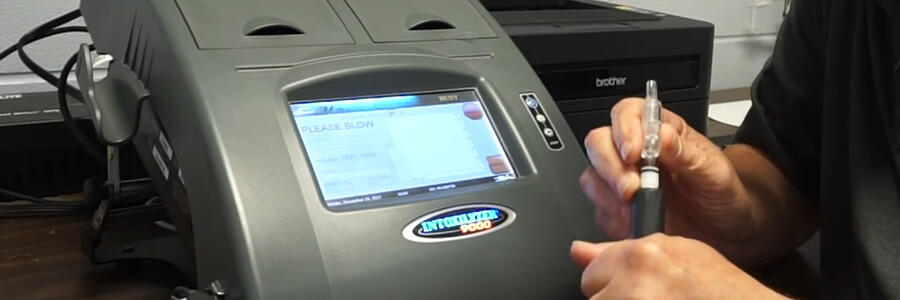Intoxilyzer 9000: Controversial Breathalyzer Used to Determine DUI
The Intoxilyzer 9000 has become a controversial tool for determining levels of intoxication for those arrested for driving under the influence (DUI). As advances in technology have led to increasingly stringent DUI laws, the Intoxilyzer 9000 has been employed by law enforcement as an effective way to determine if a suspect is intoxicated. Here, we will discuss how this device works, the flaws associated with its use, and some key court cases surrounding its use in determining drunk driving cases.
What Is Intoxilyzer 9000?
The Intoxilyzer 9000 is a handheld breathalyzer testing device used by police officers to measure blood alcohol concentration (BAC) in suspected drunk drivers. It measures BAC levels through a chemical reaction between the alcohol on the user’s breath and an oxidizer contained in the device. The oxidizer converts the ethanol present into acetaldehyde which is then measured by the device in order to calculate the user’s BAC level. The device is generally used as a tool to help assess whether or not a driver is too impaired to operate a motor vehicle safely.

Intoxilyzer 5000 vs. Intoxilyzer 9000
When it comes to breathalyzers, there are two major players: The Intoxilyzer 5000 and Intoxilyzer 9000. Both of these devices are used by law enforcement officers to quickly measure alcohol levels in a person’s blood (BAC). But while they may seem similar, they are actually quite different.
The Intoxilyzer 5000 uses infrared spectroscopy to measure the amount of alcohol in a person’s breath, while the Intoxilyzer 9000 uses both infrared spectroscopy and electrochemical fuel cell technology. The electrochemical fuel cell technology used in the Intoxilyzer 9000 is said to be more accurate and reliable than the technology used in the Intoxilyzer 5000.
Intoxilyzer 5000
The Intoxilyzer 5000 is an older model of the Intoxilyzer, first released in the late 80s. The Intoxilyzer 5000 is a smaller, handheld device that can be easily carried by police officers in their patrol cars, while the Intoxilyzer 9000 is a larger, stationary device that is typically located at a police station or other central location.
The reliability of the readings from the Intoxilyzer 5000 has indeed been questioned, mainly due to potential sources of error such as the calibration of the device, environmental factors, and potential interference from other substances in a person’s breath.
Intoxilyzer 9000
The Intoxilyzer 9000, on the other hand, is a much newer and more advanced model of the Intoxilyzer, but both devices are still in use. This device was first released in 2009 and it has since become a mainstay in many police departments around the US. The Intoxilyzer 9000 is said to be more accurate and reliable than the Intoxilyzer 5000. It can measure a person’s BAC up to 0.4%, which is well above the legal limit for driving under the influence.
How Does the Intoxilyzer 9000 Work?
The Intoxilyzer 9000 uses an infrared-based technology called photometry. This technology is based on the absorption of light. When light passes through a substance, some wavelengths are absorbed, while others pass through unchanged. Different substances absorb or reflect different wavelengths of light. Alcohol is one of those substances.
The Intoxilyzer 9000 consists of two main parts: a breath chamber and its associated electronics. Within the breath, the chamber is an infrared light source and a detector that measures the amount of light passing through a person’s breath sample. If there is alcohol present in the breath sample, some of the wavelengths of light will be blocked, changing the amount of light reaching the detector. The device then calculates the ratio between the amount of light blocked by the alcohol and the total amount of light passed through the sample. This ratio is known as the “breath alcohol concentration” (BrAC). The BrAC is then measured against a preset reference point, which indicates whether or not a person is impaired.
The Intoxilyzer 9000 is a complex and sophisticated device that uses advanced technologies to accurately detect the presence of alcohol in someone’s system. By understanding the science behind this device, we can better appreciate why it is so important for law enforcement to use it in order to ensure road safety and protect the public from drunk drivers.
Accuracy and Reliability Issues
Despite its widespread use, there have been numerous questions surrounding the accuracy and reliability of Intoxilyzer 9000 as an evidence-gathering tool in DUI cases. Oftentimes, these tests are conducted using outdated technology, meaning they may not accurately reflect a user’s current BAC level. Additionally, the device can easily be affected by external factors such as temperature and humidity, which can lead to unreliable results. Furthermore, since the Intoxilyzer 9000 requires users to properly exhale into the machine, this can potentially affect the accuracy as well, particularly if the user does not provide an adequate sample of their breath.
The Intoxilyzer 9000 has the capability to detect trace amounts of other substances that may be present in a person’s breath, such as acetone or other chemicals that can be mistaken for alcohol. This feature allows the Intoxilyzer 9000 to produce more accurate results in cases where other substances may be present.
Critics of the device argue that individuals who suffer from certain medical conditions such as diabetes or allergies can give false readings due to elevated sugar levels in their breath. The forensic consultant in this video tested the Intoxilyzer after eating a honey bun and allegedly got a false positive for alcohol.
Beating Intoxilyzer Tests
In some cases, it is possible to effectively challenge an Intoxilyzer test result in court. People who have tested positive for drunk driving and wish to contest the charges can do so by presenting evidence proving that their BAC level was either inaccurate or below the legal limit at the time of the test. This can be done through witness testimony, medical documents, or expert testimony from a healthcare professional. Additionally, any environmental factors that could have potentially affected the test results (such as improper calibration of the device or incorrect usage) can also be presented as evidence in court.
Court Cases Involving Intoxilyzer 9000
The use of Intoxilyzer 9000 has been challenged numerous times in court. In 2012, a case involving two defendants who were facing drunk-driving charges based on test results from an Intoxilyzer 9000 was heard in the Supreme Court of Canada (R. v. St-Onge, 2012 SCC 57). The defendants argued that their rights had been violated by being forced to submit to an unreliable test and provided evidence showing that the device had not been properly calibrated prior to being used. The court ultimately sided with the defendants, ruling that their constitutional rights had been violated and that the test results were inadmissible. This set a precedent for future decisions related to Intoxilyzer test results and established guidelines for how they should be used in criminal proceedings.
FAQs on Intoxilyzer
What is an Intoxilyzer?
An Intoxilyzer is a device used to measure blood alcohol content (BAC) in individuals who are suspected of being impaired by alcohol. It works similarly to a breathalyzer but uses infrared spectroscopy to make more accurate BAC measurements.
Is an Intoxilyzer a breathalyzer?
An Intoxilyzer is different from a breathalyzer. While both devices measure BAC, an Intoxilyzer uses infrared spectroscopy to make more accurate readings than the traditional breathalyzers.
What is the problem with Intoxilyzers?
The main issue with Intoxilyzers is that they can be prone to errors and inaccurate readings. This is due to their reliance on older technology and the lack of standardized protocols for calibrating and monitoring the devices.
How does an Intoxilyzer work?
When an individual blows into an Intoxilyzer, specialized sensors measure the infrared light that passes through the sample and calculates the amount of alcohol present in the breath sample. This information is then used to determine the individual’s BAC.
How does the Intoxilyzer differ from the breathalyzer?
The biggest difference between a breathalyzer and an Intoxilyzer lies in how each device measures BAC. A breathalyzer uses a chemical reaction in order to measure BAC, whereas an Intoxilyzer uses infrared spectroscopy. Additionally, standard breathalyzers may be prone to human error, while Intoxilyzers are seen as being more reliable.
Why are breathalyzers bad?
Breathalyzers can be unreliable and prone to inaccurate results, making them less effective at determining whether someone has actually been drinking or not. Additionally, if these tests are not administered correctly, they can lead to inaccurate results that could cause harm to innocent individuals.
How long will 1 beer show up on a breathalyzer?
Depending on your body weight, age, gender, and other factors, one beer can take anywhere from 30 minutes to two hours to show up on a breathalyzer.
How long will 2 beers show up on a breathalyzer?
Once again, how long it takes for two beers to show up on a breathalyzer depends on various factors such as body weight, gender, and age. Generally speaking, however, two beers should register on the test within around 45 minutes to three hours.
How long will alcohol show up on a breathalyzer?
The amount of alcohol present in your system will typically take about 30 minutes to two hours before it is detectable on a breathalyzer.
Will an interlock detect nonalcoholic beer?
No, an interlock device or breathalyzer will not usually detect non-alcoholic beer as it contains no alcohol whatsoever.
Can a breathalyzer detect alcohol in the air?
No, a breathalyzer is unable to detect alcohol that is not directly present in a person’s mouth or lungs. As such, it cannot detect any airborne alcohol particles.
Can a breathalyzer detect isopropyl alcohol?
No, a breathalyzer will not detect isopropyl alcohol as it is not detectable in the human body or on one’s breath.
Conclusion
Overall, while Intoxilyzer 9000 tests can often be helpful in determining a person’s level of intoxication, it is important to remember that there are some potential inaccuracies associated with them. For this reason, it is important that people facing DUI charges based on Intoxilyzer 9000 test results take steps to fully understand their rights and make sure they are properly using this technology. By doing so, those accused of DUI will be able to ensure that their constitutional rights are secure and that any evidence presented against them is accurate and reliable.
Additional Resources
Breath Alcohol Training – Intoxilyzer 9000 https://www.gpstc.org/training-at-gpstc/sign-up-for-training/breath-alcohol-training-intoxilyzer-9000/
Intoxilyzer resources for Evidential Breath Alcohol Testing (EBAT) https://cdphe.colorado.gov/laboratory-services/evidential-breath-alcohol-testing-ebat/intoxilyzer-resources-for-evidential
Admissibility of Breath Tests: Must an Intoxilyzer 9000 Operator Check a Subject’s Mouth? https://kansaslawreview.ku.edu/kansas-criminal-procedure-survey/admissibility-of-breath-tests-must-an-intoxilyzer-9000-operator-check-a-subjects-mouth/




